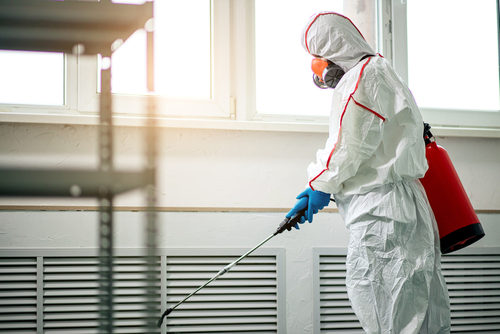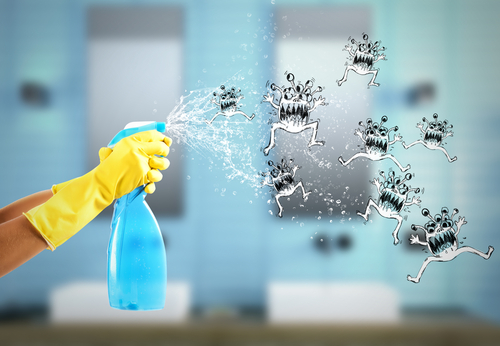
How To Protect Myself From The Delta Variant?
September 29, 2021
5 Reasons To Hire Office Disinfection Services
November 30, 2021What is the Difference Between Decontamination and Cleaning?

What is the Difference Between Decontamination and Cleaning? Cleaning and decontaminating are two different processes, but they go hand in hand. Cleaning is the removal of dirt and other contaminants from a surface with detergents or soap and water. With physical contamination, such as blood or chemicals, we use specific cleaning agents for that type of material.
Decontamination removes chemical and biological hazards from objects by using disinfectants like bleach to kill any bacteria on the surface. Both processes help us keep our environment clean so diseases can’t grow on surfaces! In this article, we’ll discuss the difference between decontamination and cleaning.
Decontamination vs. Cleaning

Decontamination is removing or destroying contaminants on surfaces. Cleaning is removing dirt, soil, and stains from a surface. We can consider cleaning as a basic form of decontamination because it removes many familiar sources of contamination.
Cleaning should not get confused with decontamination, which are two different processes that serve different purposes in maintaining sanitary conditions.
Decontaminating removes contaminants while cleaning removes dirt and other substances that make surfaces dirty. Both processes are necessary to maintain sanitary conditions in any environment. Here are apparent differences between cleaning and decontamination, including:
- Decontamination: Decontamination and cleaning are unique processes. When decontaminating a space, the overall goal is to eliminate all microbes from that space so that people or other organisms can safely occupy it. This may not coincide with making the place look spotless and shiny again, but decontamination is more of a process than merely doing cleanup work on an area of contamination.
- Cleaning: Cleaning is a matter of physically removing dirt from surfaces and objects. You can do cleaning with detergents that contain decontaminating agents such as hypochlorite but also contain non-decontaminating ingredients such as soap, moisturizers, softeners, emulsifiers, oils, and glycerin.
- Decontamination: The decontamination of surfaces and objects requires you to use biocides (chemicals that kill living things) such as cleaning agents with sodium hypochlorite (bleach). These decontamination products may also contain acids (phosphoric acid), chelating agents (EDTA), solvents (isopropyl alcohol), and surfactants (sodium lauryl sulfate).
These decontamination chemicals break down the cell membrane of microorganisms to either kill or inactivate them. - Cleaning: Cleaning agents may pose low acute toxicity through ingestion or inhalation exposure. However, they can irritate sensitive tissues. Surfactants can cause both decontamination and the cleanup of dirt from surfaces.
5 Easy Ways To Differentiate Between Cleaning and Decontamination

Decontamination is necessary to reduce the number of microorganisms in an area to avoid dangerous levels. It may involve treating objects or surfaces with decontaminant chemical solutions (disinfectants), heat (pasteurization), radiation (electron beam), ozonation, etc., to destroy microorganisms.
These microorganisms may include bacteria, fungi, viruses, spores, and more, present on the surface of objects or in the environment.
Cleaning makes the object clean by removing contaminants. This usually implies physical processes, while decontamination may require chemical agents for cleaning surfaces and instruments, disinfectant cleaners for decontaminating places, decontaminating liquids, and decontrolling garments and equipment before reusing to reduce microorganisms that can contaminate people.
For instance, you may know these five differences:

- Decontamination involves treating an area with chemicals to destroy microorganisms and clear hazards, whereas cleaning involves physically removing dirt from surfaces and objects.
- Cleaning does not mean killing all living things, and we use decontamination to decontaminate the items.
- Cleaning may mean removing dirt from surfaces and objects. In contrast, decontamination means eliminating contaminants such as microorganisms, toxic chemicals, or biological substances that can cause disease or other hazards in a place or on an object after exposure.
- Decontamination may involve the application of decontaminant liquid chemical solutions (disinfectants), heat (pasteurization), radiation (electron beam), ozonation, etc., to destroy microorganisms, including bacteria, fungi, viruses, spores, etc. which are present on the surface of objects or in the environment.
- You clean to make an object clean by removing contaminants such as dirt decontamination, chemicals decontamination, and decontaminating water decontrolling garments. You can also decontaminate equipment before reuse to reduce microorganisms that can contaminate people.
Decontamination

Decontamination may involve decontaminating only a tiny portion of an object or decontaminating the whole object. You may decontaminate items using specialized decontamination solutions that are sprayed onto one surface at a time, removing contaminants without leaving residue behind.
You remove the equipment used during decontamination after each use, so there is no chance of cross-contamination between areas or objects.
Decontamination is used to decontaminate the surrounding areas of crime scenes to ensure that you decontaminate all items before they can contaminate one another. It also decontaminates the area immediately surrounding the victim’s body to ensure nothing contaminates any evidence nearby.
Most people also use decontamination to decontaminate operating rooms and other areas that may get infected with pathogens or toxins. You can decontaminate these items after surgery, medical procedures, and autopsies to remove any contaminants left behind by blood, chemicals, and carcasses.
Even though these areas must remain sterile while being used for their intended purpose, decontamination ensures that no harmful contaminants remain when it gets finished.
Cleaning

While decontaminating does not pose any health risks, cleaning your kitchen counters is entirely unnecessary for decontamination. If you are preparing chicken that was not rinsed off, decontaminating your countertop by wiping down the surface with bleach will remove any viruses or bacteria that may have contaminated the countertop.
However, decontamination does not mean disinfecting. After decontaminating a surface, simply clean it with soap and water to ensure it becomes adequately sanitized. There’s no need for harsh chemicals!
Whereas decontamination involves killing germs or other harmful organisms through chemical or physical means, cleaning involves the removal of unwanted particulates (such as dirt and hair) from an object.
Cleaning can also refer to simple things like dusting off furniture or scrubbing the floors. While decontamination is used to sterilize living and non-living things, cleaning can get done for maintenance (such as vacuuming your carpet every three months) or aesthetic reasons.
What is the Difference Between Decontamination and Cleaning? – Final Thoughts

Decontamination is the process of removing or reducing bacteria, viruses, fungi, and other microorganisms from an item. Cleaning removes dirt and grime, but not contaminants that could cause illness. If you’re unclear about these definitions, check out this article for more information on decontaminating your home or office.




